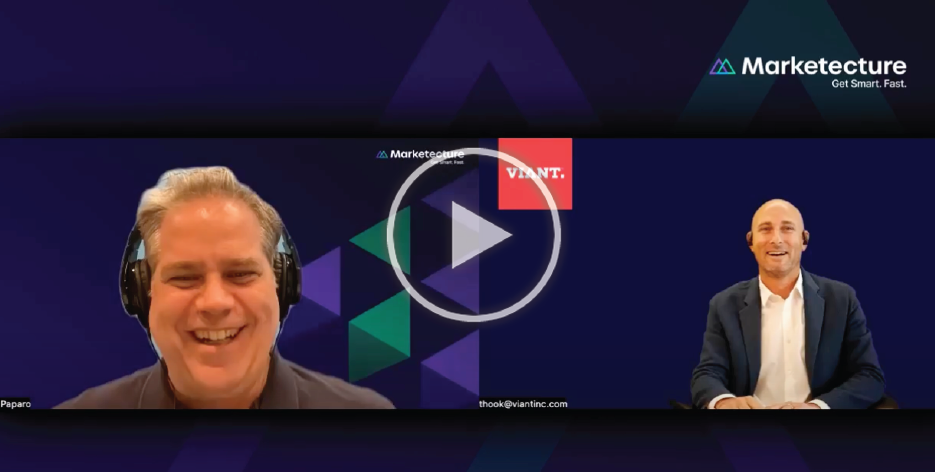How audience-based DSPs are offering marketers improved performance and future-forward approaches

Produced in partnership with Marketecture
The following article highlights an interview between Tim Vanderhook, co-founder and CEO at Viant and Ari Paparo, founder and CEO of Marketecture. Register for free to watch the discussion and learn more about how audience-based DSPs improve advertisers’ performance and offer future-forward targeting approaches.
Brands and the agencies that work with them are always looking for more efficient ways to reach their target audiences at scale via unique, privacy-compliant targeting methods. However, identifying tools that will accomplish these goals is a perennial challenge.
For example, demand-side platforms (DSPs) promise powerful outcomes. Yet, many DSPs use identifiers that aren’t compatible across technologies or vendors and aren’t future-proofed for the evolution of privacy legislation. The way forward for advertisers is increasingly focused on technology rooted in an audience-based model, with machine learning and a more forward-thinking universal ID to provide teams with better performance, a wider range of targeting methods and a more robust DSP.
To help unpack what that tech looks like, Tim Vanderhook, Viant’s co-founder and CEO, recently spoke with Ari Paparo, founder and CEO of Marketecture; they discussed building audiences, using machine learning and paths toward a new universal ID.
How machine learning and audience-based models drive better performance for advertisers
Brands and agencies want efficient ways to reach their target audiences and can do so effectively with audience-based models. If they couple this method with an audience-based DSP, they can leverage additional tech capabilities, such as machine learning, to maximize performance.
The best way to get started is with a known group of their customers. This allows the DSP to tell them much more information than the old way of creating a fictitious demographic that might like the company’s product.
By beginning with those who have purchased already, the team can work with the audience-based DSP to reach additional similar audiences.
From here, advertisers have a couple of options. They can use the platform to build lookalike audiences based on their known ones, but there’s also a machine learning element that adds something new to the equation.
“The historical way of retargeting past website visitors or with any publisher-based buy meant banner burnout or video performance burnout,” Vanderhook said. “The performance starts very high, then it degrades over time. But, when you’re running these machine learning segments, you don’t experience those same effects when going after these audiences. With machine learning, it figures out who that next person is before they come to your website, and it takes away that lack of performance over the course of time.”
Meanwhile, more traditional retargeting methods meant collecting a large group of users and exposing them to ads. Some would convert, but the performance would wane until new-in-market consumers appeared. The machine learning method added onto an audience-based model within an audience-focused DSP allows advertisers to see steady performance throughout a campaign.
Making the case for a new, ‘ultimate’ universal ID
While the industry has shifted to using some form of digital identifiers, with guidelines and restrictions now targeting these identifiers, advertisers are pursuing new options. Some have taken to utilizing hashed email addresses, but consumers are only sometimes willing to register their email in exchange for specific information, rendering the identifier useless.
Because consumers’ lives are increasingly hybrid — i.e., they are sometimes getting products delivered and other times picking things up — home addresses have become a data point regarding digital identifiers.
Vanderhook sees this as the future of the quest for the universal ID — a stable element that offers numerous targeting capabilities and isn’t regulated by big tech. It’s not something any tech group can take away from marketers or publishers. Furthermore, the fidelity of the data is very high, adding to the attractiveness for advertisers and publishers alike.
“I think household addresses in some form is ultimately going to be the universal ID that all of us are operating on,” Vanderhook said. “Especially given the way that online and offline work together now and the many devices that we all have, which we all call channels. I have been of the belief that the universal ID for the industry to settle on should be households or home addresses because It’s the only way to tie online and offline.”
Advertisers are finding that audience-based DSPs offer them a range of benefits with the ability to bring known audiences, build lookalike ones, utilize machine learning to target more effectively and for better performance — and access to a future-forward ID that just might be the universal solution for which the industry is looking.
————————————————
Register for free to watch the discussion between Ari Paparo and Tim Vanderhook and learn more about how audience-based DSPs improve advertisers’ performance and offer future-forward targeting approaches.
More from Digiday

Earnings from social and search players signal that AI will be a long-play investment
Giants like Google, Meta and Microsoft say investors and advertisers might have to wait longer for AI to generate a better return on investment.

Camila Cabello es la nueva imagen de BACARDí, la estrategia de marketing de la marca es una explosión del Caribe
Suscríbete al newsletter de Digiday en Español aquí para recibir las últimas noticias sobre el sector de marcas y la industria del marketing. La cantante cubana Camila Cabello compartió con sus más de 65 millones de seguidores en Instagram el video del comercial de su nueva asociación con BACARDí, en el clip de 30 segundos […]

Why some publishers aren’t ready to monetize generative AI chatbots with ads yet
Monetization of generative AI chatbot experiences is slow going. Some publishing execs said they’re not ready to add advertising to these products until they scale or can build a subscription model first.





